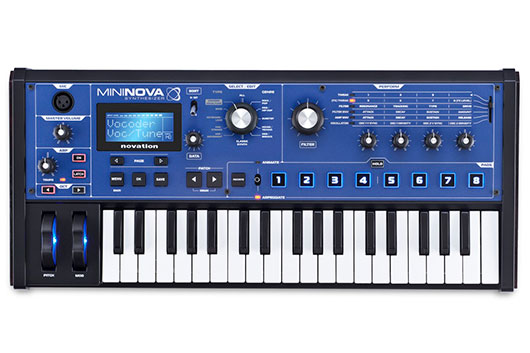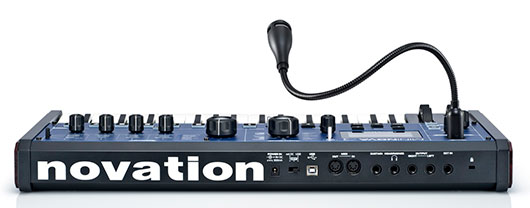Review: Novation MiniNova
As even a cursory glance at the MiniNova will reveal, it’s a synth that’s been […]

As even a cursory glance at the MiniNova will reveal, it’s a synth that’s been designed with immediacy in mind. Like Korg’s microKorg, it benefits from the relative simplicity of its interface: A clearly designed dashboard features dedicated controls for its genre patch selector, vocoder, and arpeggiator, as well as easy access to all variables and a dedicated filter knob. For added accessibility, eight big, chunky, rubberized buttons sit just above the keybed, which can toggle between arpeggiation and animation effects controls. Above this, there’s a matrix of editable parameters, with rotary dials and a slider to move between groups of four parameters each. It’s a smart idea, and better than the standard buttons used to cycle up or down through groups of different parameter.
And things get deep: Each patch can feature up to three oscillators, and 36 wavetables are also on offer, along with 14 different types of filters (two can be used for each patch). Add on top of that, there are six envelope generators, three LFOs, and 20 modulation slots for control parameters (along with five effects slots from an included seven effects), and there’s an incredible amount of depth for shaping sound. The MiniNova comes with 256 presets, along with space for 128 user patches (it’s actually compatible with patches for its big brother, the NovationUltraNova, which means there are tons of alternate patches readily available).

The on-board vocoder (the MiniNova ships with its own microphone) also includes something called VocalTune. This essentially lets your vocals to be tuned by playing melodies on the keyboard; it’s similar to standard vocoding, but pitch-shifts your voice while leaving it less processed by the machine. All in all, the vocoding and VocalTune features are incredibly fun, and add a great performance layer to the device.
The MiniNova can be powered either by an external power supply or via USB, and at roughly 22″ long by 10″ wide and 5.5 pounds, it’s an incredibly capable synth for its size and portability (though battery power would have been a nice option). There are perhaps unsurprising trade-offs, however, the first of which being that the MiniNova uses mini keys in order to squeeze 37 of them into its small frame (see: microKorg). Likewise, while deep and full of options and parameters, actually accessing some of its more advanced synth-editing capabilities involves a lot of menu-surfing. While the “genre wheel” is a pretty useful device, it’s also a bit too specific; rather than choosing between genres of music (including dubstep, house/techno, etc), it would have been nice to have these organized in to more descriptive, meaningful groupings.
Ultimately, the MiniNova feels like a more modern, more powerful imagining of the miniKorg, full of thoughtful touches like the ability to function as a plug-in inside your DAW of choice (by using a graphical editor). It’s an unquestionably powerful beast in a portable package at a solid price point, and yet another attractive option for producers—particularly those of the performance-oriented variety.
MSRP: $499

